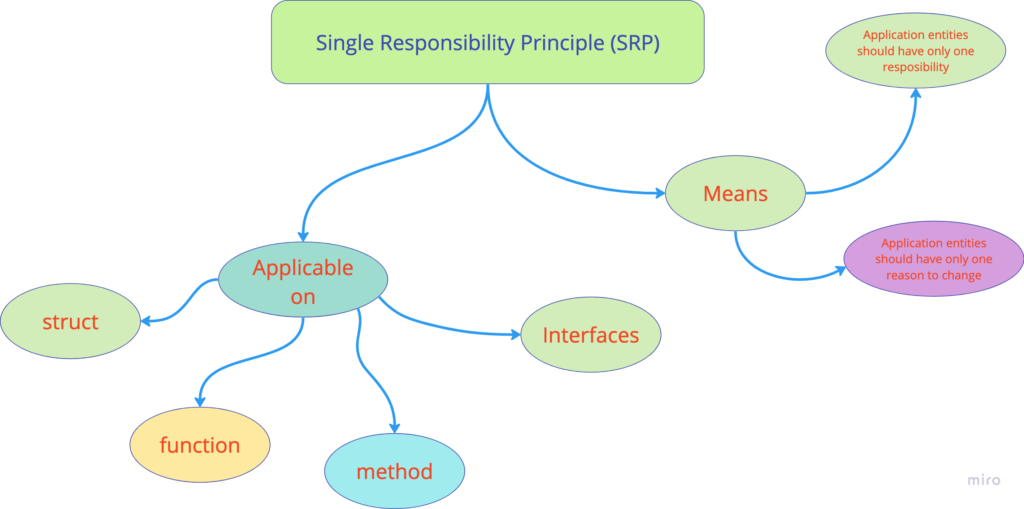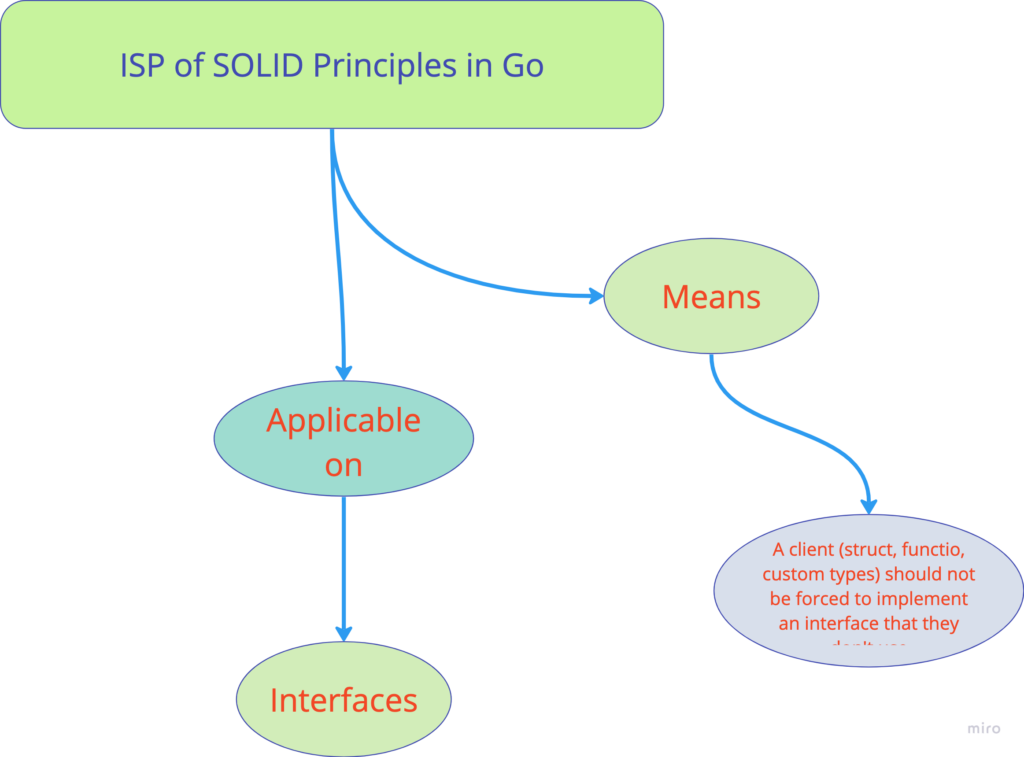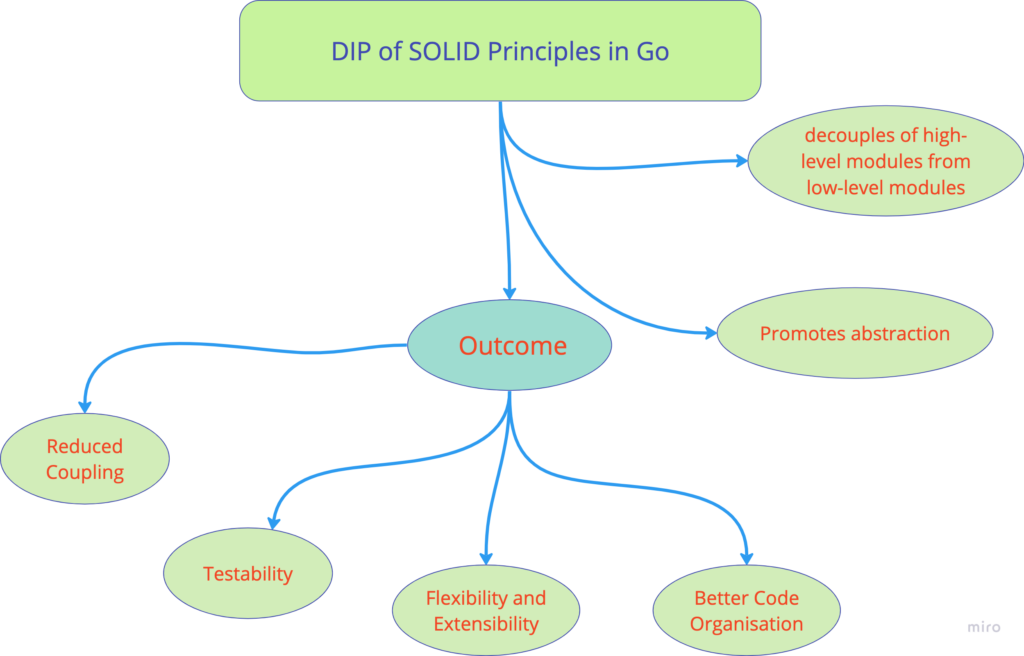Introduction
Software development is a dynamic and ever-evolving field, with countless languages and paradigms vying for our attention. Among these, the SOLID principles stand as timeless pillars of software design and development. Named after the 5 principles they represent, SOLID provides a framework for writing code that is not only functional but also maintainable, scalable, and adaptable.
In this post, we will delve into the world of Golang, a programming language known for its simplicity, performance, and concurrency capabilities. We will explore how the SOLID principles can be applied in the context of Golang to produce clean, maintainable, and robust code.
By understanding and implementing SOLID principles in Golang, you’ll be better equipped to create software that not only meets immediate needs but also stands the test of time, making it easier to extend, maintain, and adapt as requirements evolve. So, let’s embark on this journey of writing maintainable Golang code by embracing SOLID principles.
Prerequisites
5 SOLID Principles in Golang

Single Responsibility Principle (SRP of SOLID Principles in Golang)
The Single Responsibility Principle (SRP) is one of the SOLID principles of software design, which focuses on ensuring that a class or module should have only one reason to change. In other words, it should have a single responsibility. SRP is important because it encourages code that is easier to understand, modify, and maintain, ultimately leading to more robust and scalable software.
In Go, adhering to SRP involves creating types and functions that perform one specific task or have one primary responsibility. Let’s consider a practical example in the context of a web application.

Suppose you’re building a simple e-commerce website in Golang. One of the essential components of this application is the product management system. You might have a “Product” struct that represents a product’s attributes, such as its name, description, price, and availability.
type Product struct {
ID int
Name string
Description string
Price float64
InStock bool
}
Now, to adhere to SRP, you’d want to ensure that the “Product” type is responsible only for representing a product’s data and state. Other responsibilities, like persisting product data to a database or rendering product information on the web page, should be handled by separate components.
For example, you might create a dedicated “ProductRepository” to handle database operations:
type ProductRepository struct {
// Database connection and methods for CRUD operations
}
func (repo *ProductRepository) Save(product Product) error {
// Database save logic
}
func (repo *ProductRepository) GetByID(id int) (Product, error) {
// Database retrieval logic
}
Similarly, a “ProductWebHandler” can be responsible for rendering product information on web pages:
type ProductWebHandler struct {
// Web-related methods and dependencies
}
func (handler *ProductWebHandler) RenderProductPage(product Product) {
// Rendering logic
}
By adhering to SRP, you ensure that each component has a single responsibility. The “Product” struct focuses on representing product data, the “ProductRepository” deals with data storage, and the “ProductWebHandler” handles web-related tasks. This separation of concerns enhances code readability, maintainability, and testability.
The benefits of following SRP in Go projects include improved code organization, easier testing of individual components, and the ability to make changes to one aspect of the system without affecting others. In the long run, this principle contributes to a more maintainable and extensible codebase, making it easier to adapt to evolving requirements and scale the application.
Open-Closed Principle (OCP of SOLID Principles in Golang)
The Open-Closed Principle (OCP) is one of the SOLID principles of object-oriented design. It states that software entities, such as structs, packages, and functions, should be open for extension but closed for modification. In the context of Go development, OCP encourages the creation of code that is adaptable to new requirements without necessitating changes to existing, tested code. This concept aligns well with Go’s core design philosophy of simplicity and scalability.
In Golang, you can implement the Open-Closed Principle by designing your code to allow for the introduction of new functionality through extensions and interfaces without altering the existing, working code. Let’s consider an example.

Suppose you are working on a notification system for an e-commerce application. Initially, you have a simple notification service that sends email notifications to users when they place an order. The notification service might look like this:
type EmailNotificationService struct {
// Configuration for sending emails
}
func (ens *EmailNotificationService) SendNotification(user User, message string) {
// Logic to send an email
}
Now, you want to extend the system to send SMS notifications as well. Instead of modifying the existing one, you can follow OCP by creating an interface, such as NotificationService, that abstracts the behavior of sending notifications:
type NotificationService interface {
SendNotification(user User, message string)
}
With this interface in place, you can create a new implementation for sending SMS notifications without changing the existing code:
type SMSNotificationService struct {
// Configuration for sending SMS
}
func (sns *SMSNotificationService) SendNotification(user User, message string) {
// Logic to send an SMS
}
By adhering to OCP, you’ve made the system open for extension because you can add new notification services (e.g., push notifications, and in-app notifications) without modifying the original code. This is essential in Golang development, especially for large-scale applications where requirements are subject to frequent changes.
The Open-Closed Principle helps in writing robust and adaptable Golang applications by reducing the risk of introducing bugs when adding new features. It promotes the use of interfaces to define contracts and enables you to create new implementations that conform to those contracts. This approach simplifies testing and allows you to switch implementations without disrupting the rest of the application.
In conclusion, the Open-Closed Principle in Golang facilitates extensibility, maintainability, and adaptability by encouraging developers to create code that is open for new features but closed for modification. By adhering to this principle, you can build robust and scalable Golang applications that can evolve to meet changing requirements without compromising existing functionality.
Liskov Substitution Principle (LSP of SOLID Principles in Go)
The Liskov Substitution Principle (LSP) is one of the SOLID principles of object-oriented design. It was introduced by Barbara Liskov in 1987 and is a fundamental principle that guides the use of inheritance in programming. LSP states that objects of a derived class should be able to replace objects of the base class without affecting the correctness of the program. In Golang, a language that promotes composition over inheritance, LSP emphasizes the importance of adhering to contracts or interfaces when designing types.

To illustrate LSP in Go, let’s consider a simple example involving geometric shapes. We’ll define a “Shape” interface and two types that implement it: “Circle” and “Square.”
type Shape interface {
Area() float64
}
type Circle struct {
Radius float64
}
func (c Circle) Area() float64 {
return math.Pi * c.Radius * c.Radius
}
type Square struct {
SideLength float64
}
func (s Square) Area() float64 {
return s.SideLength * s.SideLength
}
The LSP ensures that if we use the “Shape” interface to work with different shapes, we can substitute any derived type without altering the program’s correctness. For example, you can calculate the total area of a list of shapes without knowing their concrete types:
func CalculateTotalArea(shapes []Shape) float64 {
totalArea := 0.0
for _, shape := range shapes {
totalArea += shape.Area()
}
return totalArea
}
The advantages of adhering to LSP in Golang for building reliable systems are numerous:
- Code Reusability: LSP encourages the creation of code that is easily reusable. You can add new shapes or derived types without changing existing code, making it more adaptable to future requirements.
- Testing and Maintenance: LSP simplifies testing as you can substitute derived types with mock implementations for testing purposes. It also makes maintenance easier, as changes to derived types don’t affect the base class or other derived types.
- Interoperability: LSP promotes interoperability between different parts of a Golang application. When you adhere to well-defined interfaces, it becomes easier to integrate components from various sources into your system.
- Parallel Development: Different teams or developers can work on derived types independently without interfering with the overall system’s functionality, as long as they conform to the established interface (contract).
- Extensibility: LSP is essential in Golang for extensibility, as it allows you to introduce new types or behaviors without disturbing the existing codebase. This is crucial for building scalable and adaptable systems.
In summary, LSP in Go enforces a fundamental principle in object-oriented design that ensures derived types can seamlessly substitute their base types. This principle is pivotal for building reliable, maintainable, and extensible systems in Go, promoting code reusability, simplifying testing and maintenance, and facilitating parallel development and system extensibility.
Interface Segregation Principle (ISP of 5 SOLID Principles in Golang)
The Interface Segregation Principle (ISP) is one of the SOLID principles of object-oriented design, emphasizing that clients should not be forced to depend on interfaces they do not use. In Golang, which prioritizes simplicity and composition, ISP plays a crucial role in streamlining client code, making it more maintainable and scalable.
ISP achieves its goal by breaking large, monolithic interfaces into smaller, more specific ones. This ensures that clients only need to implement or depend on the parts of the interface that are relevant to them. The result is more focused and less bloated interfaces, leading to cleaner and more efficient code.

Let’s look at a practical Golang example to understand ISP. Suppose you are working on a media player application, and you have a “MediaPlayer” interface that currently includes methods for both audio and video playback:
type MediaPlayer interface {
PlayAudio()
PlayVideo()
}
Now, according to ISP, it’s better to split this interface into two separate, more specific interfaces—one for audio and one for video:
type AudioPlayer interface {
PlayAudio()
}
type VideoPlayer interface {
PlayVideo()
}
This refactoring adheres to ISP by allowing clients to implement or depend on only the interface that matches their requirements. For instance, a component responsible for audio playback can now implement the “AudioPlayer” interface without being forced to include unnecessary video-related methods.
The advantages of adhering to ISP in Golang are significant:
- Client-Focused Code: ISP simplifies client code by ensuring that clients only need to interact with the parts of the interface that are relevant to their responsibilities. This reduces complexity and improves code readability.
- Modularity: Breaking interfaces into smaller, more focused parts increases modularity, making it easier to add or modify functionality without affecting unrelated parts of the code.
- Maintainability: ISP enhances code maintainability by reducing the risk of unintended side effects when changes are made. It’s easier to test and update isolated interface segments.
- Scalability: As a project evolves, ISP allows for more efficient integration of new components that adhere to specific interfaces. This promotes the scalability of Go applications.
By embracing the Interface Segregation Principle in Golang, you ensure that your codebase remains clean and efficient. With smaller, more focused interfaces, you simplify client code, promote modularity, and improve maintainability and scalability. This results in a more adaptable and maintainable Golang application, ready to meet evolving requirements.
Dependency Inversion Principle (DIP of 5 SOLID Principles in Golang)
The Dependency Inversion Principle (DIP) is one of the SOLID principles of object-oriented design, focusing on the decoupling of high-level modules from low-level modules and promoting the use of abstractions to facilitate this decoupling. In the context of Golang, a language that emphasizes simplicity and composition, DIP plays a pivotal role in building flexible and maintainable projects.
DIP’s significance in Golang projects lies in its ability to reduce tight coupling between components, making it easier to modify, test, and extend the codebase. It encourages the use of interfaces or abstract types to define dependencies, allowing for flexibility and interchangeability in the implementation of those dependencies.

Let’s delve into a Golang example to illustrate DIP. Consider a simple scenario involving a data storage service and a data processing service. Initially, the data processing service depends directly on a specific storage implementation:
type StorageService struct {
// Methods for data storage
}
type DataProcessingService struct {
Storage StorageService
}
func (dps *DataProcessingService) ProcessData(data string) {
// Process data and use the StorageService
}
To adhere to DIP, we would define an interface that abstracts the storage behavior:
type DataStorage interface {
Store(data string)
}
type StorageService struct {
// Methods for data storage
}
type DataProcessingService struct {
Storage DataStorage
}
func (dps *DataProcessingService) ProcessData(data string) {
// Process data and use the DataStorage interface
}
With this modification, the DataProcessingService now depends on an abstraction (DataStorage) rather than a concrete implementation. This allows for more flexibility in choosing the specific storage service at runtime, making the codebase more adaptable to changes and testing.
The benefits of adhering to DIP of 5 SOLID Principles in Golang development are significant:
- Reduced Coupling: DIP helps in reducing tight coupling between high-level and low-level components. This decoupling enhances code maintainability and simplifies modifications and extensions.
- Testability: By using abstractions to define dependencies, you can easily substitute real implementations with mock objects or alternative implementations, simplifying testing and ensuring that tests focus on individual components.
- Flexibility and Extensibility: DIP makes it straightforward to switch or add new implementations of dependencies without altering the high-level components. This flexibility is crucial for maintaining and evolving Go projects.
- Better Code Organization: By adhering to DIP, you ensure that dependencies are well-organized and abstracted, leading to cleaner and more readable code.
In conclusion, the Dependency Inversion Principle in Golang promotes decoupling and the use of abstractions to define dependencies, resulting in more flexible, maintainable, and adaptable projects. By adhering to DIP, you can reduce coupling, improve testability, and ensure that your Golang codebase remains open for extension without compromising existing functionality. This principle is fundamental in building scalable and robust Golang applications.
Conclusion
In this post, we’ve explored the application of 5 SOLID principles in Golang, a language that places a premium on simplicity, composition, and scalability. Each of the five SOLID principles—Single Responsibility (SRP), Open-Closed (OCP), Liskov Substitution (LSP), Interface Segregation (ISP), and Dependency Inversion (DIP)—provides a valuable framework for writing clean, maintainable, and scalable Golang code.
By following the SRP of 5 SOLID principles, we ensure that our code focuses on a single responsibility, leading to better organization and easier maintenance.
OCP of SOLID principles encourages extensibility without modification, allowing for the seamless addition of new features.
LSP of SOLID principles ensures that derived types can substitute their base types, promoting reliability and robustness. ISP simplifies client code by breaking interfaces into smaller, client-focused parts.
ISP of SOLID principles ensures smaller, more focused interfaces, simplifies client code, promotes modularity, and improves maintainability and scalability. This results in a more adaptable and maintainable Go application, ready to meet evolving requirements.
DIP of SOLID principles reduces coupling, enhances testability, and offers flexibility and extensibility. Not following DIP leads to poor code quality and more maintenance work and bug fixes. We can find many opportunities in code where DIP can significantly enhance code quality.
The importance of applying SOLID principles in Golang cannot be overstated. It leads to code that is more adaptable to changing requirements, easier to test, and simpler to maintain. Whether you’re working on a small project or a large-scale application, these principles provide a solid foundation for building software that stands the test of time.
In closing, I encourage you to embrace SOLID principles in your Golang development journey. By doing so, you’ll be well-equipped to write clean, maintainable, and scalable code that not only meets today’s needs but also paves the way for a more agile and adaptable future.
Enjoy the post!!!
2 thoughts on “Unlock Code Mastery: 5 SOLID Principles In Golang for Performance”